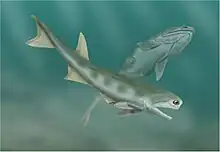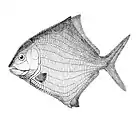| Platysomus Temporal range: | |
|---|---|
 | |
| Platysomus gibbosus | |
| Scientific classification | |
| Domain: | Eukaryota |
| Kingdom: | Animalia |
| Phylum: | Chordata |
| Class: | Actinopterygii |
| Order: | †Palaeonisciformes |
| Family: | †Platysomidae |
| Genus: | †Platysomus Agassiz, 1833 |
| Type species | |
| †Platysomus striatus Agassiz, 1833 | |
| Other species | |
| |
| Synonyms | |
| |

Platysomus gibbosus

Fossil of Platysomus circularis in the Field Museum of Natural History, Chicago
Platysomus (from Greek: πλατύς platys, 'broad' and Greek: σῶμα sôma 'body')[1] is an extinct genus of ray-finned fish that lived in the Carboniferous and Permian periods. Fossils have been found worldwide.
Platysomus was about 18 centimetres (7.1 in) long, and shaped similarly to the discus fish, having the same flattened body and elongated dorsal and anal fins. Its jaws were placed vertically under the braincase, giving it a wide gape. Platysomus is thought to have fed on plankton, and lived in both fresh and salt water.[2]
References
- ↑ Roberts, George (1839). An etymological and explanatory dictionary of the terms and language of geology. London: Longman, Orme, Brown, Green, & Longmans. p. 135. Retrieved 30 December 2021.
- ↑ Palmer, D., ed. (1999). The Marshall Illustrated Encyclopedia of Dinosaurs and Prehistoric Animals. London: Marshall Editions. p. 35. ISBN 1-84028-152-9.
This article is issued from Wikipedia. The text is licensed under Creative Commons - Attribution - Sharealike. Additional terms may apply for the media files.







